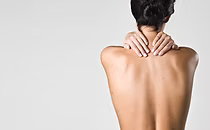
Dr. Michael Lax
Chiropractor
Helping You Reach Your Full Potential

Welcome to my practice
Whether you are recently injured or have been suffering with pain for a long time, I am here to help you get better quickly and effectively. Life is short, and my goal is to see that you return to doing the activities you love as soon as possible!
At my home clinic on Slater Place, I provide over 35 years experience and expertise as a chiropractor, movement consultant and soft-tissue specialist.
My areas of expertise include:
- spinal & postural alignment issues
- back and neck pain
- headache
- running and other sports injuries
- muscle and joint pain
Why Chiropractic and Soft Tissue Care?
These are some of the things I can help…
What Our Patients Say
Diane’s Story
My name is Diane and I live in Salmon Arm, BC. I am an active 65-year old woman who has suffered from “Frozen Shoulder” (Adhesive Capsulitis) since being diagnosed in 2016. An x-ray and ultrasound showed I had calcium deposits and bursitis in the shoulder. I proceeded to have cortisone injections and acupuncture, but nothing helped. The pain level elevated during the summer of 2019 to the point where it was very painful to do even basic chores. Sleep was terrible as it was nearly impossible to find a comfortable position for my arm. The pain made me wake up many times during the night.
In September, 2019 the pain became even more unbearable and I could not raise my arm at all. I had more cortisone injections, physio, chiropractic and acupuncture sessions, all without any relief. I was finally referred to a neurosurgeon. The expected wait time was 18 – 24 months; needless to say, this was not positive news.
Then in November, 2019 I was fortunate to read about Dr. Lax and his Trigenics treatment for Frozen Shoulder. I contacted Dr. Lax, and we arranged for me to begin treatment. The problem was that I live in Salmon Arm, and his office is in Victoria! However, we made it work, and after the first 3 appointments, during the week of November 12 – 16, I was able to finally sleep more restfully. After a series of 9 more appointments over a 6 week period, I gained approximately 50% range of motion back in the shoulder.
Dr. Lax presented me with a series of exercises that supported his treatments. It is now the end of January, and after 3 treatments this past week, Dr. Lax and I are both very happy with my recovery. I presently have about 80% range of motion back, with no discomfort in the shoulder. My goal, as I continue to work through the exercises, is to gain the additional 20%.
Thank you, Dr. Lax, for your gentle treatments, strong support and encouragement. I can honestly say that without your care and Trigenics treatments I would not have been able to garden the total of 4½ hours this week, at least not without suffering unimaginable pain. But even more importantly, I can now lift my 14-month old granddaughter well above my head, totally pain-free!
Diane B.
Therese’s Story
Due to a car accident many years ago I’ve had a lot of back problems and 4 spinal surgeries. I now have degenerated discs. Before I saw Dr. Michael I could hardly get around, even with my cane, due to constant and severe pain. I lived on various pain medications, as well as cortisone, which helped for a couple of weeks until the pain came back.
I had been to chiropractors before my first surgery and that had helped at the time. However, after my back operations I was afraid to go back for care. Some time later I talked to my denturist, a patient of Dr. Michael’s. He told me about the treatment he had received from Dr. Michael and said he felt sure it would help me. I decided to give it a try.
My first impressions of the doctor’s office were very good. Dr. Michael made me feel confident he could help me, and I have been very pleased with the results of my treatment. My pain has really diminished, I would say by at least 70%. My walking is much stronger and more balanced, and I haven’t had leg cramps at night.
I would definitely recommend Dr. Michael to others who are suffering or in pain. Since receiving care I have told a number of my friends about him. I’ve also told my family doctor how much better I now feel. I’d like to extend a special thanks to for what he has done for me.
Therese W.
Barry’s Story
For 10 years I’d experienced a number of physical problems, from lower back and neck pain to stiffness, fatigue and a visual drop in my right hip.
I was referred to a massage therapist who told me my condition was due to age and degeneration of the discs in my spine. I tried many therapies, but nothing worked.
When Dr. Michael came highly recommended to me, I decided to give him a try. I felt I had nothing to lose, and at the very least it probably wouldn’t hurt to have a second opinion.
Dr. Michael’s office is a very caring environment. After an investigation, the Doctor suggested I try a program to actually fix my problem. I couldn’t believe my ears because I had accepted my problem as fate. Once he started treating me I experienced an immediate reduction in pain and discomfort. I had better movement, and felt happier and more confident in my appearance. Three quarters of the way through my program I was able to get back into sports, which I had given up for 10 years.
I certainly recommend Dr. Michael’s care to others. Today I am 42 years of age and I just got back into some sports that I used to enjoy when I was a teenager. I now have better movement in my body than I did when I was eighteen!
Barry H.






